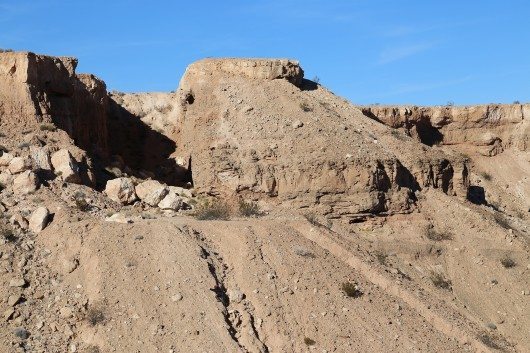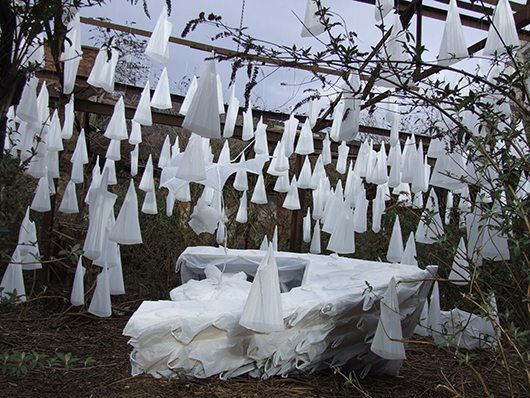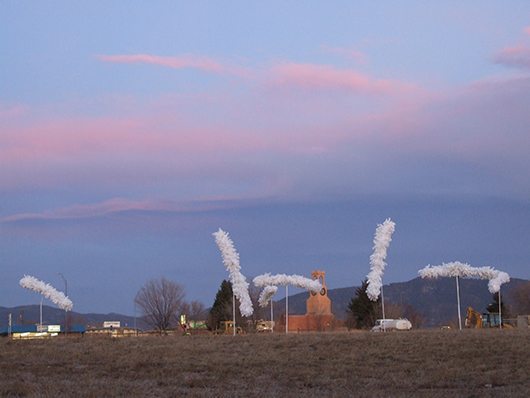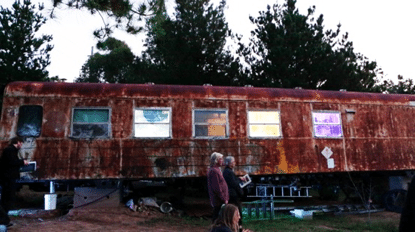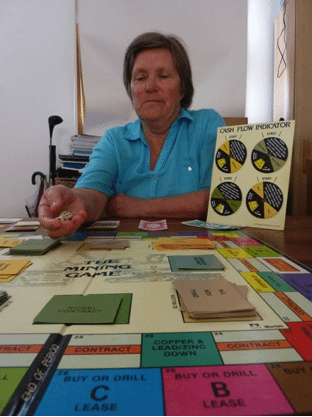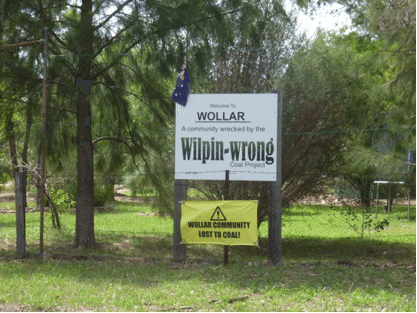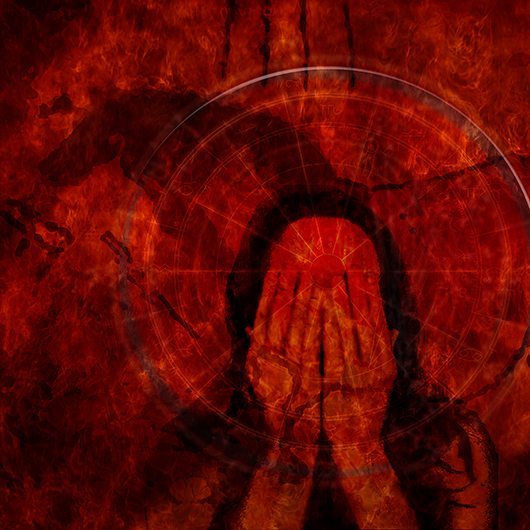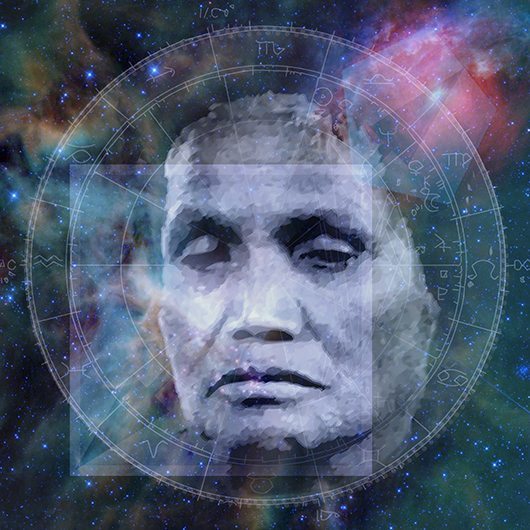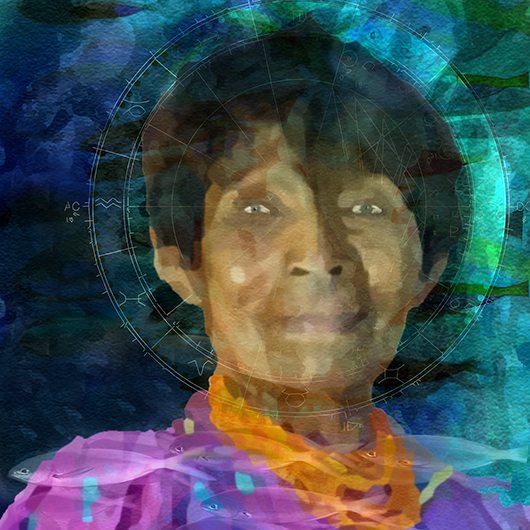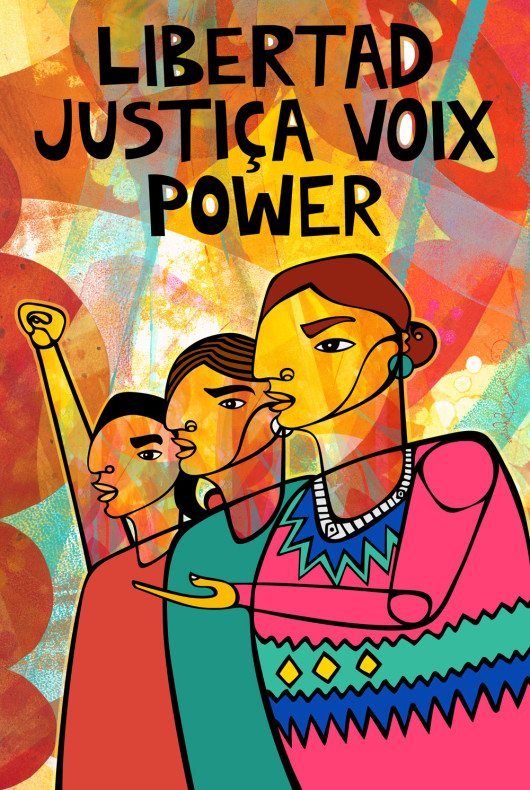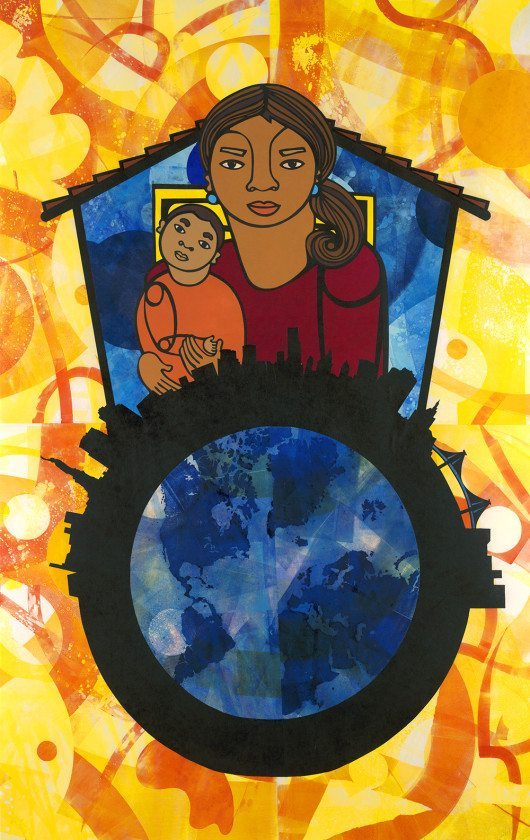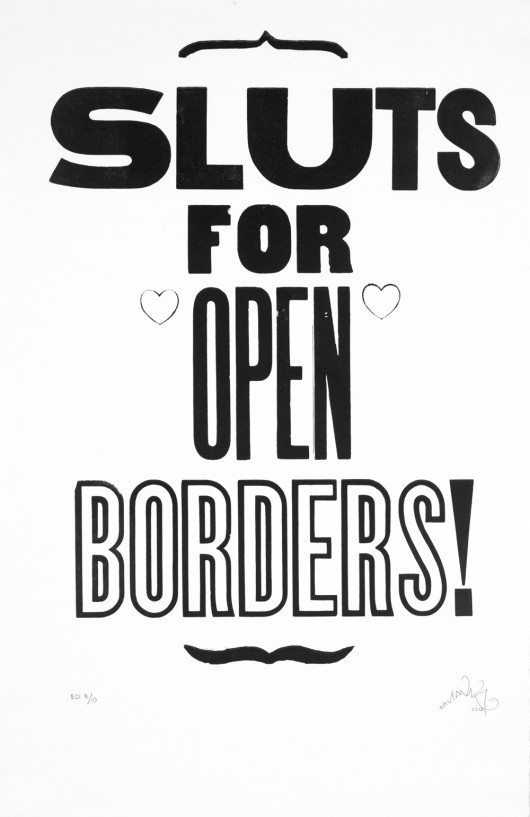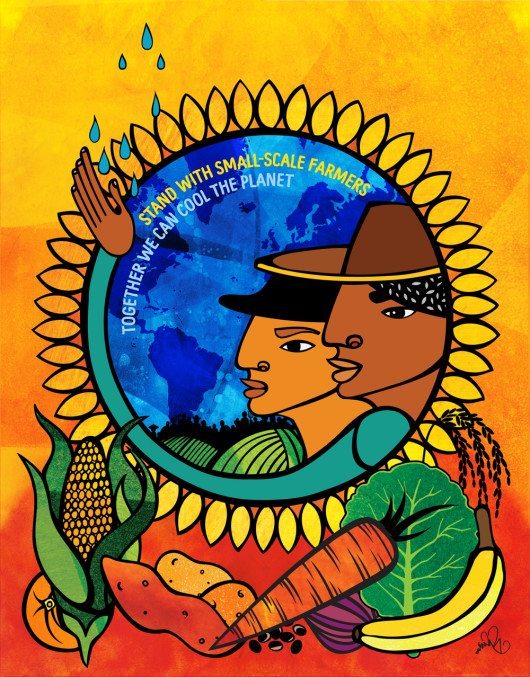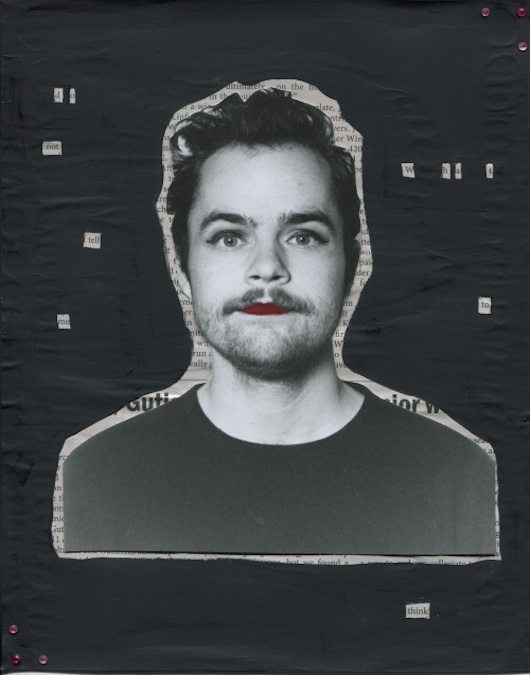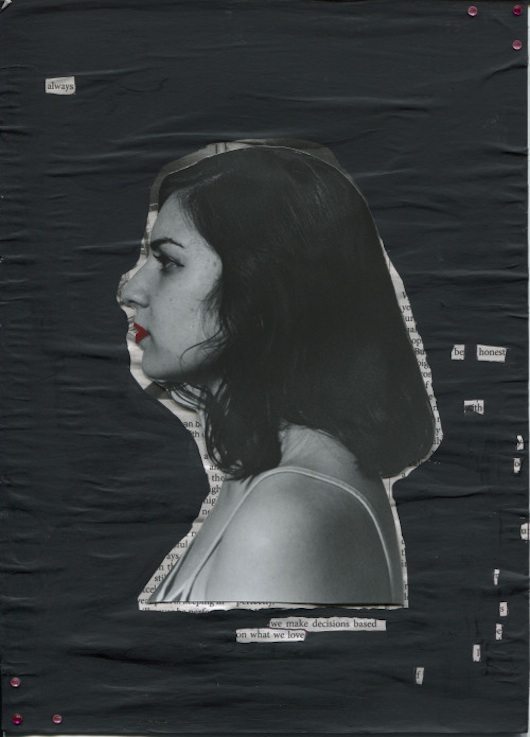Title: WEAD ARTISTS PORTFOLIO
Open only to WEAD listing artists and members, each Portfolio is curated by the Editorial Committee to showcase artists whose work reflects diverse approaches to the issue’s theme.
ARTISTS
Meghan Moe Beitiks
Claudia Borgna
Jenny Brown
Verona Fonte
Anna Olsson
Faviana Rodriguez
Shayna Weimer
MEGHAN MOE BEITIKS
“Ecofeminists have perhaps been most insistent on some version of the world as active subject, not as resource to be mapped and appropriated in bourgeois, Marxist, or masculinist projects. Acknowledging the agency of the world in knowledge makes room for some unsettling possibilities, including a sense of the world’s independent sense of humor,” writes Donna Haraway.1
In Embracing the Void, I am a speck, a dot, in the landscape of Double Negative, a work of Land Art by Michael Heizer (1969-70).
The Dia Foundation writes: “Although the “sculptural volume” of Double Negative was created by a massive movement of earth, performed with the help of heavy machinery, it isn’t physical at all. Instead it is made literally of nothing, of negative space: the volume that traditionally defines a sculpture is described in these works by a void, by absence rather than presence.”2
The site of Double Negative itself is overwhelming in its scale, surpassing the space carved out by earth-movers. In Embracing the Void, I attempt to give Michael Heizer a hug: you can see the little speck of me in the center lower portion of the frame. Writes Haraway, ” I am arguing for politics and epistemologies of location, positioning, and situating, where partiality and not universality is the condition of being heard to make rational knowledge claims . . . I am arguing for the view from a body, always a complex, contradictory, structuring, and structured body, versus the view from above, from nowhere, from simplicity.”3 In Embracing the Void, I throw myself emotionally and bodily at Michael Heizer’s work, occupying gendered spaces of both support and cold distance.
END NOTES
1 In ” Situated Knowledges: The Science Question in Feminism and the Privilege of Partial Perspective,” Feminist Studies, Vol. 14, No. 3 (Autumn, 1988), pp. 593
2 http://www.diaart.org/exhibitions/introduction/83
3 In ” Situated Knowledges: The Science Question in Feminism and the Privilege of Partial Perspective,” Feminist Studies, Vol. 14, No. 3 (Autumn, 1988), pp. 589
In the movie “Erin Brockovich,” the citizens of Hinkley, CA receive a massive payout for the pollution of their drinking water by PG&E. In reality, the pollutant hexavalent chromium is still seeping through the bedrock, and some citizens who did not own property were left behind in the settlement. I take a moment from the film– a sigh performed by Albert Finney as Ed Masry– and re-perform that sigh at various dilapidated sites within Hinkley. Masry’s sigh is exasperation at Brockovich’s relentlessness. As I embody it, it takes on different meanings.
CLAUDIA BORGNA
STATEMENT:
Over the years I have been confronting how rubbish and man-made objects are transforming and creating new landscapes; an ‘evolution’ generated by modern lifestyle and consumption. After working with a variety of discarded materials, I decided to focus on working with plastic bags. Plastic bags epitomize the quintessential discarded object, a symbolic vessel wondering across the landscape. I find plastic bags interesting because of their remarkable contradictory qualities. Plastic bags are in fact, worthless and useful, ephemeral and eternal, and above all ‘democratic’ and universal.
To better express the concepts of environment, space, time and duration I materialized my ideas through installations. These are large to give a sense of multitude and mass – as in mass-production – to the point of suffocation by invading and taking over space. My work borrows concepts and thehegemony of western beauty as tools to capture and play with the values of capitalist culture and its consumerist ideology of manic production and consumption but also using beauty and aesthetics. While my aesthetics sense and vision are rather intuitive and feminine/feminist ones inspired by nature. It is through persistent repetitive actions that I build my plentiful landscapes of repurposed plastic. In the same way that – many trees make a forest; many drops mould the sea; and many grass blades grow into a meadow – plastic bags create a constantly evolving landscape that mimics the cyclic and repetitive rhythms of nature but in fact are activated by a mechanized Fordist methodology. The sheer scope of the work lures the viewers into artificial landscapes that float from the tangible to the intangible and drift into a lyrical extension of modern life that substitutes an idealized concept of nature with a romanticized contemporary one. The ultimate goal is to explore the tension between the contradictions of a neurotic but beautiful world where creation and destruction coexist side by side.
My working method is to change the shape of the bags just enough to suggest a new form by leaving the bags somehow recognizable, and most importantly light, airy and ephemeral. It is important to me that my work is
economically feasible making the most out of very little. Central to this endeavour is to recycle the same bags over and over and to easily deconstruct them in order to transform them further. Tape, fishing line and metal wire are my main materials with the addition of found components (such as branches, stones, ice, water, etc.). The constructions are intentionally precarious appearing on the verge of collapsing. It is vital that my work be an art in motion, not static but animated, living off the power of natural elements rather than from polluting energies: light and air are the kinetic suppliers of energy and movement. The final results are nomadic clusters of clouds of plastic bags constructions continuously morphing into archetypal formations.

NEVER THE SAME AGAIN: SEARCHING FOR NEWFOUNDLAND, Claudia Borgna, Terra Nova National Park, Newfoundland, Canada, 2010.
These hold their shapes for a few instants before moving somewhere else to become a new, yet ancient compositions inspired by nature. Throughout the years, I have collected thousands of plastic bags. Like loyal companions, we have travelled together. This has led me to realize that social injustice and environmental crises go hand in hand and are, in fact, signed by the same authors. Despite the fact that my works wants to underline the relationship, or the conflict, between culture and nature, and how they both influence and reflect each other, my ultimate artistic goal is to comment on and build an awareness of our wasteful lifestyle and how our values affect the environment. Altogether beauty for me is part of a deceiving game employed to attract the attention of the viewers in order to seduce them into a grotesque and fantastic ephemeral environment that acts as metaphor of our contemporary world. “Beauty will save the world” ― Fyodor Dostoyevsky, The Idiot.
JENNY BROWN
Jenny Brown has been a prominent Australian artist since the 1980’s. She uses a range of tactics to contribute to women activists in communities leading initiatives against local commons threats. Her work explores root problems of patriarchy and hegemony in relation to ongoing Australian political crises. These photos are from her multipronged project Solastalgia for which she produced a series of public interactive art events to support communities threatened by coal mining companies.
VERONA FONTE
EARTH
I often feel like a ‘composer’ in making art; weaving images, symbols, layers into visual portrayals that have meaning for me. This happened in the series THE ELEMENTS. My underlying motivation was to explore the elements – earth, air, water, fire – through a feminine viewpoint. A feminine perspective has been ignored to a great extent in conjuring how to preserve life on our planet, I felt this merited exploration, and wanted to see where it would take me.
In each print four components exist: a photograph of a woman*; an imprint of my personal horoscope; an environmental context which reflects the element represented, and symbols that reveals psychological elements to be examined. Obscured/hidden within each image are other details that enhance meaning (for me).
FIRE
The symbolically relevant layers were superimposed upon each other as I attempted to stretch from my personal place/time to a broad archetypal understanding of the concept of each ELEMENT. A cave painting is embedded as background in both EARTH and FIRE. The hands in the EARTH image are from caves in Patagonia, Argentina; and the horse in FIRE is from the Lascaux cave in France. In AIR the environmental context is an image taken by ALMA, an array of 66 separate radio telescopes placed high on a Chilean plane that see galaxies being born.
AIR
Time, distance, our human capacities are reflected through these backgrounds in ways that hint at a grandeur of what ‘could be’. Yet, for me, there is a psychological collapse into the despair of ‘what is’. In the WATER image, the Kuna woman I filmed decades ago is envisioned under water; as she will be if/when the oceans rise and cover the small island in the Caribbean off the coast of Panama where she lives. And in the FIRE image a woman wails over what has been lost for all of us through the destructive use of fire.
WATER
I am left with the sadness of where this exploration has taken me, and suspect this sadness may be shared by other viewers.
*The photographs of the women were taken by me, with the exception of the photograph used In Earth. This was taken by my friend Maria Jose Gutierrez from Spain.
ANNA OLSSON
I am a textile artist and a psychologist. For several years I have been working with detainees. The situation in Swedish remand centers is very difficult because the detainees are kept completely isolated. My meetings with the detainees and their inhumane situation, has become the focus of my tapestries since working there.
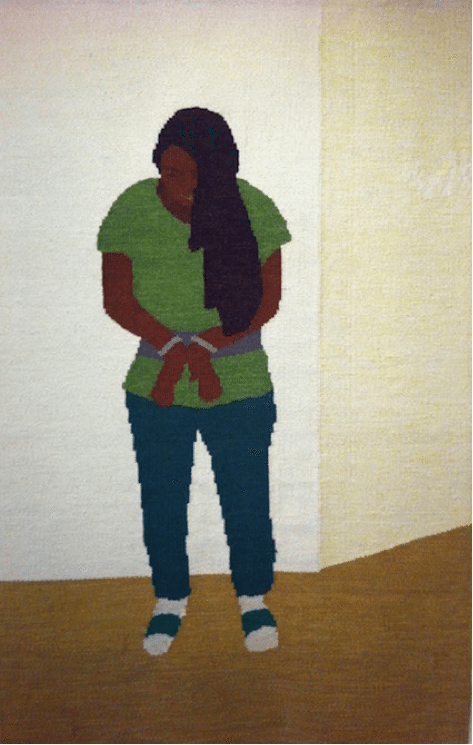
TRY TO GIVE A URINE SAMPLE WITH YOUR HANDS STRAPPED TO WAIST CUFF!, Tapestry in linen 150 x 100 cm., 2015.
In this tapestry, a woman, locked in jail, was asked to leave a urine test but both her hands and waist were locked in shackles- a completely impossible and degrading situation. After desperate pleas from the woman she finally got one hand disengaged and managed with only one hand free to provide the urine sample.
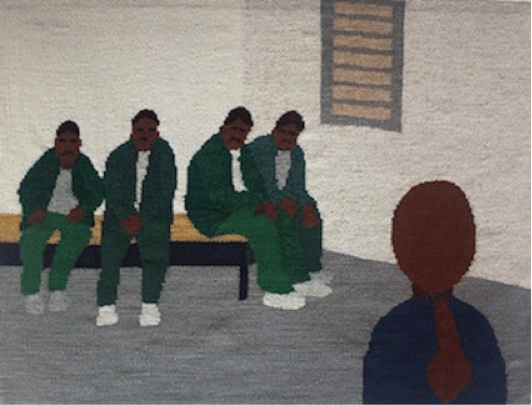
EVERYONE LOOKS TIRED TO ME. HOW WILL I MANAGE TO GIVE THEM HOPE?, Tapestry in linen, 120 x 90 cm., 2013.
For many detainees I’ve met in this vulnerability, I am struck by how fragile and exposed their life was before they ended up in jail. The tragedies seem to have stood in line for almost all of these people. We need to show respect for a person’s difficulties. I must find the strength to continue to give them some hope.

BEHIND EACH DOOR ANXIETY IS GROWING. A MEETING AT A TIME, DAY BY DAY AND WEEK BY WEEK. Tapestry in linen. 120 x 80 cm 2015.
Behind every door in the long prison corridor sits a person who feels bad. Whatever I do, I do not have time to meet with everyone who needs assistance or has asked for my help. I try to take a deep breath and take the work session at a time. I hope I make a difference to at least someone.
FAVIANNA RODRIGUEZ
Favianna Rodriguez is a transnational interdisciplinary artist and cultural organizer. Her art and collaborative projects deal with migration, global politics, economic injustice, patriarchy, and interdependence . Rodriguez lectures globally on the power of art, cultural organizing and technology to inspire social change, and leads art workshops at schools around the country. Favianna’s mission is to create profound and lasting social change in the world. Through her bold and provocative art, she has already touched the hearts and minds of millions. In addition to her fine arts and community work, Rodriguez partners with social movement groups around the world to create art that’s visionary, inspirational, radical and, most importantly, transformational. When Favianna is not making art, she is directing CultureStrike, a national arts organization that engages artists, writers and performers in migrant rights. In 2009, she co-foundedPresente.org, a national online organizing network dedicated to the political empowerment of Latino communities.
— Biography from http://favianna.tumblr.com/bio
SHAYNA WEIMER
INTROSPECTION- FEMALE IDENTITY series, mixed media photography.
This series of photographs is a commentary on gender presentation and gender fluidity. Although I myself present as female, I took this opportunity to explore through my artistic process what exactly that means to me and to others. The text in the images was created spontaneously, which allowed me to express my thoughts out of emotion and without premeditated criticism. The final product addresses a common internal monologue that occurs when questioning gender identity, political and economic imbalance between men and women, and beauty standards for women.

